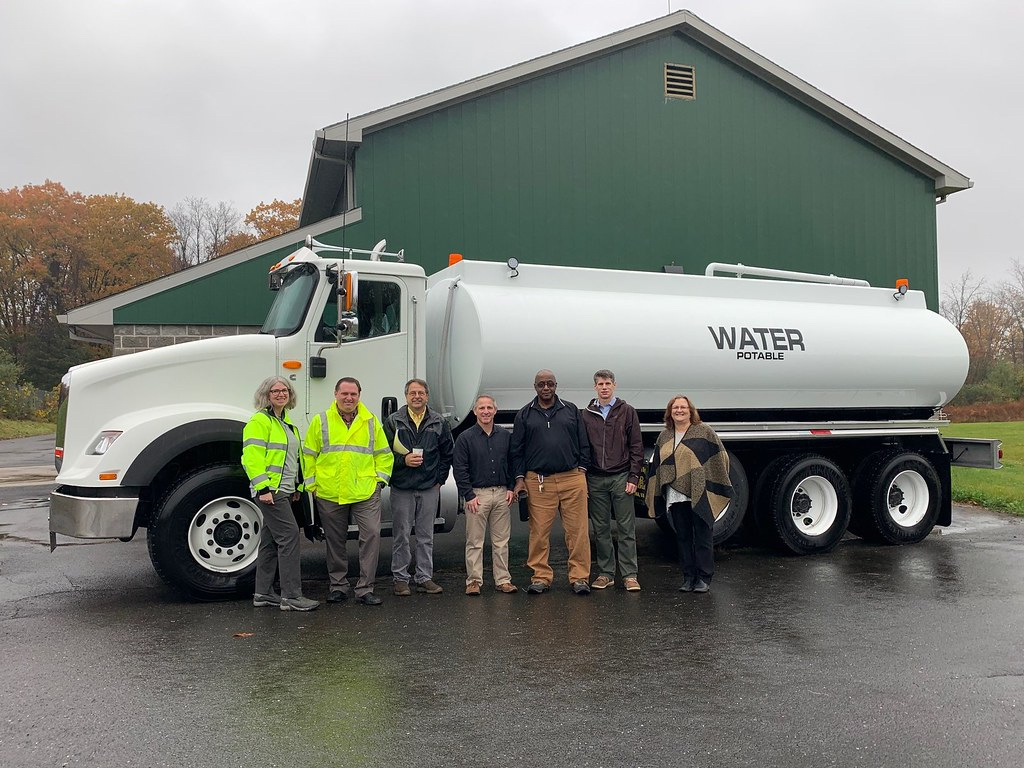DEP Joins Supervisors from Marbletown and Rosendale to Mark Delivery of New Water Truck for High Falls
November 8, 2019
The New York City Department of Environmental Protection (DEP) last week joined Marbletown Supervisor Rich Parete and Rosendale Supervisor Jeanne Walsh to mark the delivery of a truck that will provide clean drinking water to 200 homes and businesses in High Falls during the upcoming shutdowns of the Catskill Aqueduct.
DEP is currently working on a $158 million project to rehabilitate the 92-mile-long Catskill Aqueduct, which delivers drinking water from Ashokan Reservoir to New York City. The project—which includes cleaning the inside of the aqueduct, fixing leaks, and replacing century-old valves—requires DEP to shut down the aqueduct for 10 weeks each year through 2021.
While planning for the aqueduct rehabilitation, DEP identified that High Falls did not have an adequate backup supply of drinking water for its district during shutdowns of the Catskill Aqueduct. The High Falls Water District draws about 30,000 gallons of water each day from the aqueduct, which currently is the only source of water for the district.
Over the past several years, DEP collaborated with Marbletown, Rosendale and the High Falls Water District on an intergovernmental agreement to ensure the district had a reliable source of drinking water during the periodic shutdowns. Through that agreement DEP provided up to $410,000 for High Falls to invest in equipment and infrastructure. The bulk of that money went toward a 5,000-gallon water truck that will be used to shuttle clean drinking water to High Falls from the neighboring Rosendale Water District during the shutdown. High Falls received the water truck this fall and will use it during the Catskill Aqueduct shutdown that begins in November. DEP funds were also used for plumbing upgrades at the High Falls Plant, allowing the truck to convey water into its water tower and treatment plant.
“I want to thank Supervisor Parete and Supervisor Walsh for collaborating with DEP over the past several years to ensure we could repair the Catskill Aqueduct while maintaining a reliable supply of drinking water for High Falls,” DEP Deputy Commissioner Paul Rush said. “An immense amount of planning has gone into our rehabilitation of the Catskill Aqueduct—a project that is vital to the water supply for 9.6 million New Yorkers. Along the way, we were fortunate to work with our neighbors in Marbletown and Rosendale to find a solution that met the needs of their residents and our construction project.”
“I would like to thank the Department of Environmental Protection for working with the Town of Marbletown to ensure that we have adequate equipment and a back-up water supply to serve the High Falls Water District,” Marbletown Supervisor Rich Parete said. “Our priority was to make sure none of our residents or businesses noticed a difference in their water service during the aqueduct shutdowns, and DEP has worked with us to meet that goal.”
“The Town of Rosendale thanks DEP for working with both towns to provide a water truck that will ensure residents of the High Falls Water District continue to have safe drinking water during the upcoming shutdowns of the Catskill Aqueduct,” Rosendale Supervisor Jeanne Walsh said.
The High Falls Water District includes approximately 200 connections that serve nearly 500 residents along the border of Marbletown and Rosendale.
DEP manages New York City’s water supply, providing more than 1 billion gallons of high-quality water each day to more than 9.6 million New Yorkers. This includes more than 70 upstate communities and institutions in Ulster, Orange, Putnam and Westchester counties who consume an average of 110 million total gallons of drinking water daily from New York City’s water supply system. This water comes from the Catskill, Delaware, and Croton watersheds that extend more than 125 miles from the City, and the system comprises 19 reservoirs, three controlled lakes, and numerous tunnels and aqueducts. DEP has nearly 6,000 employees, including almost 1,000 scientists, engineers, surveyors, watershed maintainers and other professionals in the watershed. In addition to its $70 million payroll and $168.9 million in annual taxes paid in upstate counties, DEP has invested more than $1.7 billion in watershed protection programs—including partnership organizations such as the Catskill Watershed Corporation and the Watershed Agricultural Council—that support sustainable farming practices, environmentally sensitive economic development, and local economic opportunity. In addition, DEP has a robust capital program with $20.1 billion in investments planned over the next decade that will create up to 3,000 construction-related jobs per year. For more information, visit nyc.gov/dep, like us on Facebook, or follow us on Twitter.





